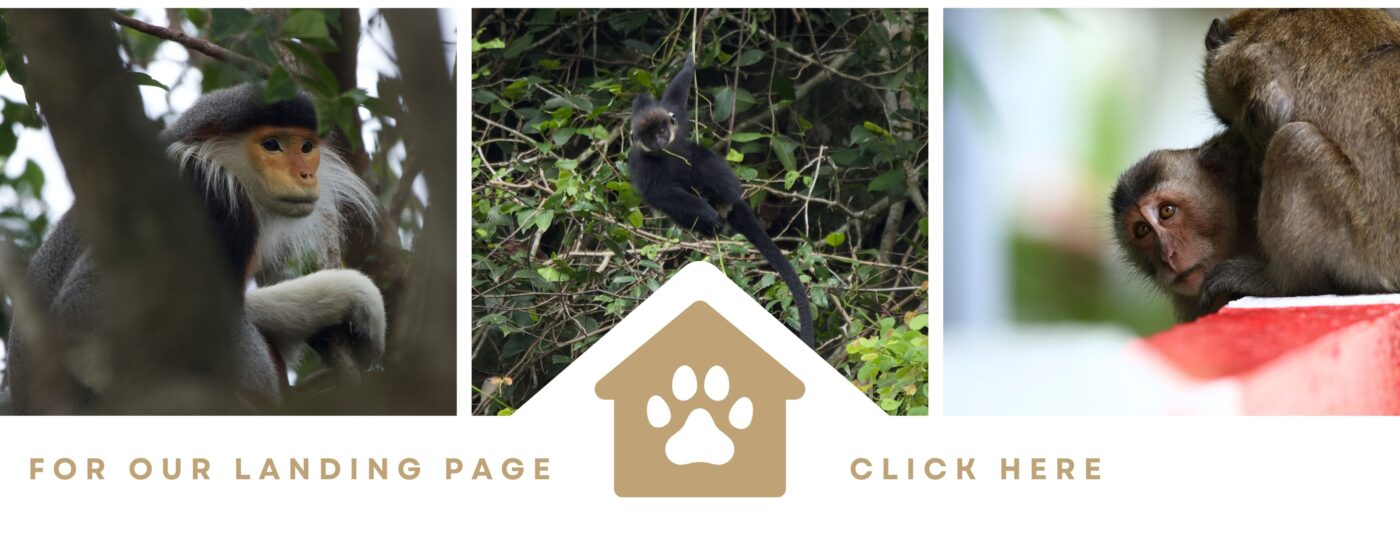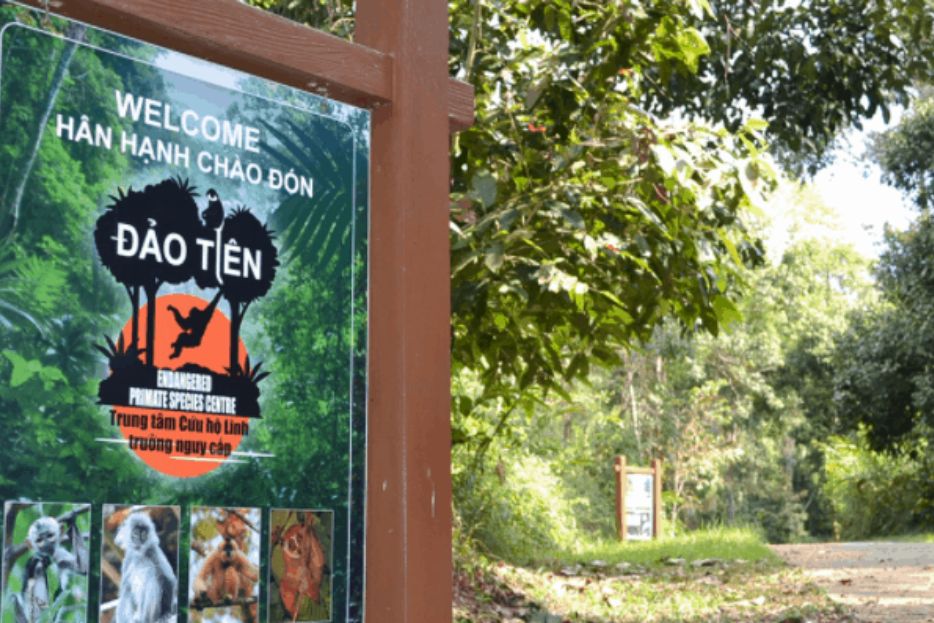Hidden within the lush embrace of Cat Tien National Park lies a haven for primate enthusiasts and nature aficionados alike. This verdant sanctuary, cloaked in emerald canopies and resonating with the symphony of the wild, stands as a treasure trove of primate diversity. Home to an array of captivating species, from the agile gibbons to the elusive pygmy lorises, Cat Tien National Park is a haven where the dance of primates enchants the soul. As one of the prime locations globally for primate watching, this sanctuary, with the guidance of “A Cat Tien Primate Watcher Guide” beckons explorers to unravel the secrets and stories woven within the tapestry of its flourishing primate communities.

The park’s habitat is characterized by dense forests with towering trees, diverse flora, and a complex network of rivers and streams. This ecosystem provides an ideal setting for a wide variety of primate species to thrive. The presence of abundant fruit-bearing trees, along with a diverse array of insects and small animals, ensures a stable food source for these primates.
Cat Tien National Park is home to several primate species, including endangered ones like the yellow-cheeked gibbon, black-shanked douc langur, and the silvered langur. These primates rely on the park’s forests for food, shelter, and breeding grounds. The interconnectedness of the park’s ecosystem plays a pivotal role in sustaining these primate populations.
The gibbons, with their acrobatic agility, swing gracefully through the upper canopy of the tropical rainforests. Living in tight-knit family groups, these territorial primates communicate through resonating calls, marking their lush habitat that comprises primarily mature secondary forests, providing an ideal landscape for their brachiation. Gibbons’ slender frames, long arms, and striking facial features add to their unique presence within the park.

Gibbons at Cat Tien National Park sing beautiful songs to communicate and mark their territory. Their calls range from hoots to melodic tunes that echo through the forest. They often sing duets with their partners, creating a harmonious symphony that carries across the trees. Watching these agile primates swinging through the treetops while singing is mesmerizing. The haunting melodies of their songs fill the forest, creating a magical atmosphere that captivates visitors. Listening to gibbons sing in this natural setting is an unforgettable experience, connecting people to the wild and primal beauty of nature.
Among the social inhabitants are the macaques, thriving in large troops within varied habitats, from forests to human-altered landscapes. Their adaptive nature allows them to dwell in primary and secondary forests, showcasing hierarchical structures within their groups. Macaques’ robust builds, long tails, and distinct facial features make them easily identifiable residents, sometimes adapting even to urban environments, illustrating their resilience in diverse settings.

Tranquil and leaf-eating langurs form another primate community in Cat Tien. These peaceful creatures spend their days feeding on foliage, residing in cohesive groups while communicating through various vocalizations. Their preference for areas rich in vegetation, such as primary and secondary forests, reflects their need for safety and abundant food sources. Diverse fur patterns, long tails, and slender bodies distinguish the langurs, highlighting their role in the park’s primate population.
Adding to the park’s nocturnal charm are the lorises, slow-moving and solitary creatures. Their nocturnal habits and deliberate tree-climbing reflect their adaptation to life in dense forests. Lorises’ large, keen eyes for night vision, compact bodies, and sometimes venomous glands in their elbows make them unique among Cat Tien’s primate inhabitants.
You may also like: 7 Primate Species in Cat Tien National Park
Primate watching is an art that requires patience, respect, and consideration for these animals and their environment. Prior research and planning are crucial—learning about the species you wish to observe helps in understanding their behaviors and preferred habitats. Always adhere to park rules and guidelines, stay on designated trails, and maintain a respectful distance from the primates. It’s essential to keep noise levels low and avoid sudden movements or direct eye contact, as these can startle or stress the animals.
Observing primates requires some basic equipment, such as binoculars or a camera with a zoom lens, allowing for a closer view without intruding on their space. Patience is key—spend time quietly observing their behaviors from a distance. Tracking and identifying primates can involve learning their calls, looking for signs like tracks or feeding remnants, and being attentive to the environment. By understanding their habits and sounds, observers can better locate and observe these animals without causing disruption.
The overarching goal of primate watching is to minimize impact. Avoid feeding or attempting to interact with the primates, as this can alter their natural behaviors and diet. It’s crucial to leave no trace—carry out any trash and leave the environment undisturbed. Environmental considerations, such as the time of day and the habitats primates prefer, can also enhance the chances of observing them without causing disturbance. Ultimately, primate watching is about appreciating these incredible animals in their natural habitat while prioritizing their well-being and conservation.

Cat Tien National Park faces various conservation challenges threatening its primate species. Habitat loss due to deforestation, agricultural expansion, and infrastructure development poses a significant threat. Fragmentation of forests disrupts the primates’ natural habitats, leading to isolation and decreased genetic diversity among populations. Additionally, illegal logging, poaching for the pet trade, and hunting for traditional medicine further endanger these species.
To counter these threats, ongoing conservation efforts focus on several fronts. Habitat preservation remains a priority—initiatives aim to protect and restore forested areas within the park, creating corridors to reconnect fragmented habitats and allow for the movement of primate populations. Community-based programs engage local residents in sustainable practices, reducing human-wildlife conflict and promoting conservation awareness.
Exploring our main theme about Cat Tien National Park or main theme of Cat Tien National Park
Anti-poaching measures and law enforcement are crucial components of safeguarding these primates. Park rangers and conservation organizations collaborate to patrol and protect against illegal hunting and logging activities. Educational outreach programs raise awareness among local communities and visitors about the importance of primate conservation, aiming to foster a sense of stewardship toward these animals and their habitats.
Scientific research plays a pivotal role, providing valuable insights into primate behavior, population dynamics, and ecological needs. This knowledge guides conservation strategies, informing decisions about habitat management and protection.Partnerships between governmental agencies, conservation organizations, local communities, and international bodies contribute to a holistic approach toward primate conservation. By addressing the complex interplay of habitat loss, poaching, and human-wildlife conflict, these collaborative efforts strive to secure the future of primate species in Cat Tien National Park while promoting the sustainability of the entire ecosystem.
Wildlife Tours to Cat Tien Primate Kingdom at WANEE
With over 100 successful tours annually, we promise a memorable adventure, achieving above 90% of our wildlife spotting targets. Convenient accommodations and enthusiastic service ensure your satisfaction. Maybe we’re not the best, but we always try our best!
Scheduled Wildlife Tours
Tailored Wildlife Tours
Click here to see more tailored tour options
Visit our sites:
– Facebook: WANEE Vietnam (Wild and Nature Exploring)
– Instagram: WANEE Vietnam and WANEE Kids hub
Are you looking for Wildlife Tours in Vietnam?
WANEE VIETNAM is your go-to destination for "Wildlife Tours in Vietnam", specializing in Birding, Primate Watching, Herping, Photography Tours and Educational Tours led by our expert guides.Hot-spot for Birding in Vietnam
all birding in hot-spot informative info [updated Jan 2023]
Nr. Nature reserve; Np. National Park; mt. Mountain
Crocodile Trail – The Best Birding Trail in Cat Tien National Park
If you’re a birder or nature photographer planning a trip to Vietnam, few places offer [...]
Cong Troi Trail – Top 1 Dalat Plateau Birding Trail Experience
If you’re a birder or nature photographer planning a trip to Vietnam’s Central Highlands, the [...]
How to Identify the Greater Sand Plover, Tibetan Sand Plover and Siberian Sand Plover
Identification Differences within the Sand Plover Complex: The sand plover group, which was traditionally divided [...]
Highlights of Cat Tien National Park Reptiles and Amphibian Endemics
Spanning over 71,350 hectares of tropical forests, grasslands, and wetlands, Cat Tien National Park is [...]
Highlights of Cat Tien National Park Mammals in a World Biosphere Reserve
In addition to reptiles and birds, Cat Tien National Park is also rich in mammals, [...]
Kontum Plateau Endemic and Highlight bird
Kontum Plateau Endemic And Highlight Bird species like Chestnut-eared Laughingthrush and top birding routes while [...]